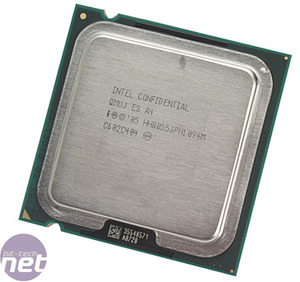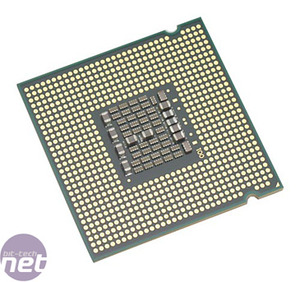It wasn't all that long ago when Intel announced its first Presler-based core, the Pentium Extreme Edition 955 processor. Since then, Conroe has been the talk of the town and we managed to grab some quick benchmarks on the new processor at the Intel Developer Forum last month. Today, Intel is announcing the successor to the Pentium XE 955, which also denotes the last stand for the NetBurst architecture that has been around since the end of the year 2000. Not surprisingly, Intel's new processor is known as the Pentium Extreme Edition 965. It's based on the same Presler core (or pair of cores) and isn't much more than a speed bumped Pentium XE 955 processor.
The 965 comes clocked at 3.73GHz (14.0 x 267MHz) with a 1066MHz front side bus - this is the same core speed as Intel's fastest single core Extreme Edition processor, the Prescott-based chip that came with 2MB of L2 cache. Since there are two separate 'Cedar Mill' cores on the same package in order to create the Presler chip, Intel is able to benefit from fantastic yields as they're able to collect two 65-nanometre Cedar Mill cores from anywhere on the wafer and install them on the same chip package.


The Pentium Extreme Edition 965 looks just like the Pentium Extreme Edition 955 processor...Since the initial launch of the Presler chip on December 27th, it has become apparent that both the Presler and Cedar Mill cores are a bridge between the 90-nanometre Prescott and Smithfield cores, and the upcoming Conroe core which is shaping up pretty damn well at the moment. Much like Presler, Conroe will be manufactured on Intel's 65-nanometre node and Intel will stay on the 65-nanometre track for some time.
Conroe is obviously a dual-core chip and there are two cores on the same die, rather than the two dies on one package method that Intel has used on the current 65-nanometre Presler chips. After Conroe, Intel's next Extreme Edition chip will be based on the Kentsfield chip. Kentsfield looks to be a pair of Conroe cores on the same chip package, making for a quad-core behemoth. This means that Intel is retiring its two dies on one package dual-core implementation, either, as Kentsfield will continue this heritage. This should help give the company some excellent yields on quad-core processors, when that time comes.
Processors:
Processors
Processors:
The 965 comes clocked at 3.73GHz (14.0 x 267MHz) with a 1066MHz front side bus - this is the same core speed as Intel's fastest single core Extreme Edition processor, the Prescott-based chip that came with 2MB of L2 cache. Since there are two separate 'Cedar Mill' cores on the same package in order to create the Presler chip, Intel is able to benefit from fantastic yields as they're able to collect two 65-nanometre Cedar Mill cores from anywhere on the wafer and install them on the same chip package.


The Pentium Extreme Edition 965 looks just like the Pentium Extreme Edition 955 processor...
Conroe is obviously a dual-core chip and there are two cores on the same die, rather than the two dies on one package method that Intel has used on the current 65-nanometre Presler chips. After Conroe, Intel's next Extreme Edition chip will be based on the Kentsfield chip. Kentsfield looks to be a pair of Conroe cores on the same chip package, making for a quad-core behemoth. This means that Intel is retiring its two dies on one package dual-core implementation, either, as Kentsfield will continue this heritage. This should help give the company some excellent yields on quad-core processors, when that time comes.
Testing the Pentium XE 965:
We didn't expect to see anything more than a speed-bumped 955 when we looked at this chip, and we were almost right. The Pentium Extreme Edition 965 comes with a new stepping of the Presler core that operates at more respectable temperatures. However, the rest of the core seems to have remained the same. Consequently, we're run a pared-down set of benchmarks on the 965 to give you an indication of how big the speed bump is.________________________________________________________________________________
Test Setup:
Intel Pentium Extreme Edition System Setup:
Intel Desktop Board D975XBX (Intel i975X/ICH7R chipset); BFGTech GeForce 7800 GT OC video card (operating at 425/1050MHz); 2x512MB Corsair XMS2-5400UL DDR2 memory (running at 667MHz DDR 4.0-2-2-8); Maxtor DiamondMax 10 250GB SATA Hard Disk Drive; LG 16x DVD-ROM drive; OCZ PowerStream 520W PSU; Windows XP Professional Service Pack 2; Intel Inf 7.22 platform drivers; NVIDIA Forceware 78.03 WHQL.Processors:
- Pentium Extreme Edition 965 - 3.73GHz, 1066MHz FSB, 2x2MB L2 cache, Hyper-Threading Technology Enabled;
- Pentium Extreme Edition 955 - 3.46GHz, 1066MHz FSB, 2x2MB L2 cache, Hyper-Threading Technology Enabled;
- Pentium 4 Extreme Edition 3.73GHz - 3.73GHz, 1066MHz FSB, 2MB L2 cache, Hyper-Threading Technology Enabled.
Intel Pentium D System Setup:
Intel Desktop Board D975XBX (Intel i975X/ICH7R chipset); BFGTech GeForce 7800 GT OC video card (operating at 425/1050MHz); 2x512MB Corsair XMS2-5400UL DDR2 memory (running at 533MHz DDR 3.0-2-2-8); Maxtor DiamondMax 10 250GB SATA Hard Disk Drive; LG 16x DVD-ROM drive; OCZ PowerStream 520W PSU; Windows XP Professional Service Pack 2; Intel Inf 7.22 platform drivers; NVIDIA Forceware 78.03 WHQL.Processors
- Pentium D 950 - 3.4GHz, 800MHz FSB, 2x2MB L2 cache;
- Pentium D 940 - 3.2GHz, 800MHz FSB, 2x2MB L2 cache;
- Pentium D 930 - 3.0GHz, 800MHz FSB, 2x2MB L2 cache.
AMD Athlon 64 System Setup:
ASUS A8N-SLI Deluxe motherboard (NVIDIA nForce4 SLI chipset); BFGTech GeForce 7800 GT OC video card (operating at 425/1050MHz); 2x512MB Corsair XMS-3200XL Pro memory (running at 400MHz DDR 2.0-2-2-10); Maxtor DiamondMax 10 250GB SATA hard drive; LG 16x DVD-ROM drive, OCZ PowerStream 520W PSU; Windows XP Professional Service Pack 2; NVIDIA nForce 4 standalone platform drivers version 6.70 WHQL; NVIDIA Forceware 78.03 WHQL.Processors:
- AMD Athlon 64 FX-60 - 2.6GHz, 1GHz HTT, 2x1MB L2 cache;
- AMD Athlon 64 X2 4800+ - 2.4GHz, 1GHz HTT, 2x1MB L2 cache;
- AMD Athlon 64 X2 4400+ - 2.2GHz, 1GHz HTT, 2x1MB L2 cache;
- AMD Athlon 64 FX-57 - 2.8GHz, 1GHz HTT, 1MB L2 cache;
- AMD Athlon 64 FX-55 - 2.6GHz, 1GHz HTT, 1MB L2 cache;
- AMD Athlon 64 4000+ - 2.4GHz, 1GHz HTT, 1MB L2 cache;
- AMD Athlon 64 3700+ - 2.2GHz, 1GHz HTT, 1MB L2 cache.

MSI MPG Velox 100R Chassis Review
October 14 2021 | 15:04







Want to comment? Please log in.